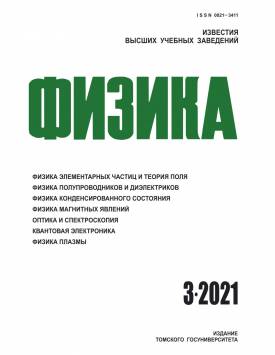Effect of carbon nanotubes on the microstructure and fracture resistance of nanostructured oxide ceramics
The structure and properties of ceramics based on zirconium dioxide stabilized yttrium oxide with the addition of high-modulus inclusions of carbon nanotubes were investigated. The composite materials were obtained by spark plasma sintering. The introduction of carbon nanotubes provides a slight decrease in the density and grain size of ceramics. Growth of volume fraction of carbon nanotubes leads to increase of mechanical properties of ceramic composites. The highest values of mechanical properties were obtained by the introduction of 5 vol.% of carbon nanotubes and were E = (246±8) GPa, H = (12.7±0.21) GPa, K 1 CI = (12.1±0.35) MPa∙m1/2, K 1 CN = (7.8±0.29) MPa∙m1/2. The increase of fracture toughness when carbon nanotubes are introduced into the ceramic matrix is caused by two dissipative mechanisms - phase transformation from tetragonal to monoclinic modification of ZrO2 and crack bridging. As the amount of introduced additive increases, the contribution of martensitic transformation in fracture resistance decreases, which is associated with a decrease in the grain size of the tetragonal zirconium dioxide phase and, accordingly, its transition to a stable state.
Keywords
oxide ceramics,
carbon nanotubes,
fracture toughness,
crack bridging,
phase transitionAuthors
| Mirovoy Yu.A. | Institute of Strength Physics and Materials Science of SB RAS | y.a.mirovoy@gmail.com |
| Burlachenko A.G. | Institute of Strength Physics and Materials Science of SB RAS | aleksburlachenko@rambler.ru |
| Buyakov A.S. | Institute of Strength Physics and Materials Science of SB RAS | alesbuyakov@gmail.com |
| Dedova E.S. | Institute of Strength Physics and Materials Science of SB RAS | lsdedova@yandex.ru |
| Buyakova S.P. | Institute of Strength Physics and Materials Science of SB RAS | sbuyakova@ispms.tsc.ru |
Всего: 5
References
Yu M.F., Files B.S., Arepalli S., and Ruoff R.S. // Phys. Rev. Lett. - 2000. - V. 84. - P. 5552- 5555.
Lee C., Wei X., Kysar J.W., and Hone J. // Science. - 2008. - V. 321. - P. 385-388.
Hai-dou Wang, Peng-fei He, Guo-zheng Ma, et al. // J. Eur. Ceram. Soc. - 2018. - V. 38. - P. 3660-3672.
Cano-Crespo R., Moshtaghioun B.M., et al. // J. Eur. Ceram. Soc. - 2018. - V. 38. - P. 3994-4002.
Becher P.F. and Swain M.V. // J. Am. Ceram. Soc. - 1992. - V. 75. - P. 493-502.
Ruiz L. and Readey M.J. // J. Am. Ceram. Soc. - 1996. - V. 79. - P. 2331-2340.
Basu B. // Int. Mater. Rev. - 2005. - V. 50. - P. 239-256.
Chevalier J., Gremillard L., Virkar A.V., and Clarke D.R. // J. Am. Ceram. Soc. - 2009. - V. 92. - P. 1901-1920.
Deng B., Luo J., Harris J.T., and Smith C.M. // Materialia. - 2020. - V. 9. - P. 100548.
Trunec M. and Chlup Z. // Scripta Mater. - 2009. - V. 61. - P. 56-59.
Салтыков С.А. Стереометрическая металлография. - М.: Металлургия, 1976. - 271 с.
Garmendia N., Grandjean S., et al. // J. Eur. Ceram. Soc. - 2011. - V. 31. - P. 1009-1014.
An J.W. and Lim D.S. // J. Ceram. Process. Res. - 2002. - V. 3. - No. 3. - Part 2. - P. 201-204.
Mazaheri M., Mari D., Schaller R., et al. // J. Eur. Ceram. Soc. - 2011. - V. 31. - P. 2691-2698.
Trunec M. // Ceram.-Silikaty. - 2008. - V. 52. - P. 165-171.
Duszov´a A. et al. // J. Eur. Ceram. Soc. - 2008. - V. 28. - P. 1023-1027.
Melk L. et al. // Ceram. Int. - 2015. - V. 41. - P. 2453-2461.
Dusza J. et al. // J. Eur. Ceram. Soc. - 2009. - V. 29. - P. 3177-3184.
Sun J., Gao L., Iwasa M., et al. // Ceram. Int. - 2005. - V. 31. - P. 1131-1134.
Hassan R. et al. // Mater. Sci. Eng. - 2017. - V. 704. - P. 329-343.
Yi J., Xue W., Wang T., and Xie Z. // Ceram. Int. - 2015. - V. 41. - P. 9157-9162.
Babu J.S.S., Lee C.H., and Kang C.G. // J. Mater. Res. Technol. - 2020. - V. 9. - P. 5278-5292.
Zhuang J., Gu D., et al. // Powder Technol. - 2020. - V. 368. - P. 59-69.
Hsueh C.H. and Evans A.G. // J. Am. Ceram. Soc. - 1985. - V. 68. - P. 241-248.
